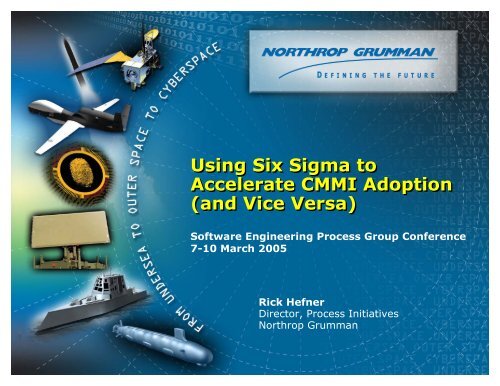Download Presentation - Software Engineering Institute
Download Presentation - Software Engineering Institute
Download Presentation - Software Engineering Institute
Create successful ePaper yourself
Turn your PDF publications into a flip-book with our unique Google optimized e-Paper software.
Using Six Sigma to<br />
Accelerate CMMI Adoption<br />
(and Vice Versa)<br />
<strong>Software</strong> <strong>Engineering</strong> Process Group Conference<br />
7-10 March 2005<br />
Rick Hefner<br />
Director, Process Initiatives<br />
Northrop Grumman
1<br />
Northrop Grumman Mission Systems<br />
Copyright 2003 Northrop Grumman Corporation<br />
• A leading integrator of<br />
complex, mission-enabling<br />
systems<br />
Intercontinental<br />
Ballistic Missile<br />
Program<br />
• 2003 Sales - ~$4.1B<br />
• 18,000 employees in 50 states<br />
and in 23 countries<br />
• 1500 active contracts<br />
Joint National<br />
Integration Center<br />
• Deep, legacy domain expertise<br />
in priority, high-growth<br />
segments<br />
• Premier provider of mission<br />
critical end-to-end solutions<br />
Satellite Command & Control<br />
Focused on program performance
Copyright 2003 Northrop Grumman Corporation<br />
Mission Success Requires Multiple Approaches<br />
2<br />
Risk Management<br />
Systems <strong>Engineering</strong><br />
Independent Reviews<br />
Program<br />
Effectiveness<br />
Dashboards for Enterprise-<br />
Wide Measurement<br />
Communications &<br />
Best-Practice Sharing<br />
Training, Tools, &<br />
Templates<br />
Process<br />
Effectiveness<br />
Mission<br />
Assurance<br />
Operations<br />
Effectiveness<br />
Robust Governance Model<br />
(Policies, Processes,<br />
Procedures)<br />
CMMI Level 5 for <strong>Software</strong>,<br />
Systems, and Services<br />
ISO 9001 and AS-9100<br />
Certification<br />
Six Sigma
3<br />
Program Effectiveness<br />
Copyright 2003 Northrop Grumman Corporation<br />
• Six Sigma connects process improvement and business value<br />
DEFINE MEASURE ANALYZE IMPROVE CONTROL<br />
Charter team,<br />
map process &<br />
specify CTQs<br />
Measure process<br />
performance<br />
Identify &<br />
quantify root<br />
causes<br />
Select, design &<br />
implement<br />
solution<br />
Institutionalize<br />
improvement,<br />
ongoing control<br />
• Six Sigma projects can help focus and measure CMMI-driven<br />
process improvements<br />
– Identify the customer’s needs, maximize the value/cost<br />
– Tools for management by variation (CMMI Levels 4 and 5)<br />
• Results to date<br />
– Over 3500 Green Belts, 200 Black Belts, 10 Master Black Belts<br />
– 529 completed Six Sigma projects, 234 in progress<br />
– Significant benefit to our customer – lower costs, better performance<br />
Assuring mission success by by identifying the the<br />
customer’s needs and and reducing defects
How CMM/CMMI Helps Six Sigma Efforts<br />
• CMM/CMMI focuses on organizational change<br />
Copyright 2003 Northrop Grumman Corporation<br />
– Provides guidance on many dimensions of the infrastructure<br />
4<br />
Process Areas<br />
Organizational Process Focus<br />
Organizational Process Definition<br />
Organizational Training<br />
Organizational Process Performance<br />
Organizational Innovation and<br />
Deployment<br />
Generic Practices (all process areas)<br />
GP 2.1 Establish an Organizational<br />
Policy<br />
GP 2.2 Plan the Process<br />
GP 2.3 Provide Resources<br />
GP 2.4 Assign Responsibility<br />
GP 2.5 Train People<br />
GP 3.1 Establish a Defined Process<br />
GP 2.6 Manage Configurations<br />
GP 2.7 Identify and Involve Relevant<br />
Stakeholders<br />
GP 2.8 Monitor and Control the Process<br />
GP 3.2 Collect Improvement<br />
Information<br />
GP 2.9 Objectively Evaluate Adherence<br />
GP 2.10 Review Status with Higher-<br />
Level Management
5<br />
Barriers and Challenges<br />
Copyright 2003 Northrop Grumman Corporation<br />
• Capturing the first, “low hanging fruit” makes Six Sigma<br />
implementation look easy…<br />
– Clearer problems, simpler solutions, bigger payoffs<br />
– Little need for coordination<br />
…but later projects are tougher<br />
– Keeping projects appraised of similar efforts, past and current<br />
– Focusing on “the pain”, not the assumed solution<br />
• <strong>Engineering</strong> process measurements are often difficult to analyze<br />
– Dirty (or no) data, human recording problems<br />
– May necessitate Define-Measure-Analyze-Measure-Analyze-etc.<br />
• Must demonstrate the value of quantitative data to managers<br />
– Management style - reactive vs. proactive vs. quantitative<br />
– Less value in a chaotic environment<br />
– Must engage customers
6<br />
Benefits<br />
Copyright 2003 Northrop Grumman Corporation<br />
Based on 16 Northrop Grumman CMMI Level 5 organizations<br />
• Having multiple improvement initiatives helps encourage a change<br />
in behavior as opposed to “achieving a level”<br />
– Reinforces that change (improvement) is a way of life<br />
• The real ROI comes in institutionalizing local improvements across<br />
the wider organization<br />
– CMMI establishes the needed mechanisms<br />
• CMMI and Six Sigma compliment each other<br />
– CMMI can yield behaviors without benefit<br />
– Six Sigma improvements based solely on data may miss innovative<br />
improvements (assumes a local optimum)<br />
• Training over half the staff has resulted in a change of language<br />
and culture<br />
– Voice of Customer, data-driven decisions, causal analysis, etc.<br />
– Better to understand and use the tools in everyday work than to adopt<br />
the “religion”
















